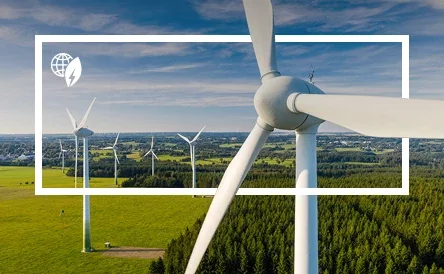
Driving Wind Energy Production Improvements
As the world electrifies, demand for sustainable and renewable energy sources is expected to rise. Our solutions can be put to work enabling the production of wind energy in a variety of applications.
As the world innovates to become more sustainable and electrified, the demand for renewable energy generation grows. Wind energy has become an attractive renewable option for utilities companies because it is cost effective and can be implemented in a wide variety of environments. Increased attention on and demand for wind energy requires companies responsible for constructing and maintaining wind turbines to figure out how to produce more power in an efficient, sustainable manner.
While building more wind turbines is a crucial step for the growth of renewable power generation, making sure that those installations produce energy as efficiently as possible is also important. Engineers designing wind turbines also need to ensure installations are protected from environmental threats and minimize the footprint of turbines where possible.
Energy Up, Footprint Down
Building a wind turbine requires time and resources, and wind energy companies need to maximize these investments and ensure each wind turbine installation generates as much electricity as possible. There are a few ways wind energy companies can tackle this challenge, but one approach is to purchase taller turbines where permitted by local regulations. Taller wind turbines reach higher into the sky where wind speed, due to a variety of atmospheric conditions, tends to be faster. Faster wind speeds spin turbines faster and generate more energy.
Taller wind turbine towers also generally require larger bases. This is both less environmentally friendly and less cost effective because of the amount of land the concrete base takes up and the increased material use that a larger base and wider tower needs. On the other hand, taller turbines can also help companies meet demand with fewer turbines, so engineers need to balance increasing wind turbine height and production efficiency while safely minimizing the size of the base.
One answer is to reduce the size of wind turbine nacelles—the body of the wind turbine at the top of the tower. Wind turbine nacelles contain the equipment that converts movement of wind turbines into electricity, including converters and transformers. One way to reduce nacelle size is to fit these parts closer together—replacing cable with an alternative solution for creating electrical connections can be a part of the solution. nVent ERIFLEX Flexibar Advanced flexible busbar boasts a high bending radius and a high degree of conductivity that enables designs that would be impossible to build safely using cable. The busbar can also carry more current while using a smaller amount of copper material than traditional cable.
Both onshore and offshore wind turbines use Flexibar busbar, which also features a low-smoke, halogen-free, flame retardant and high-temperature insulation. Using this product in compact nacelle designs can provide cost savings and increased power production efficiency, as well as reduced material use. Additionally, these customized engineering solutions facilitate easier replicability of essential components, making maintenance faster and safer while reducing waste.
Critical Support and Protection
Even the smallest wind turbine nacelles require extremely well-designed towers to hold them safely at high altitudes. Engineers must design wind turbines to weather intense winds and the constant battering of ocean waves for offshore applications. nVent LENTON couplers are hard at work connecting rebar structures in wind turbine bases and towers, supporting the immense weight of the turbines even in the harsh environments where wind turbines are often placed.
In addition to size reduction and structural stability considerations, engineers need to consider how environmental conditions can affect how turbines operate. Tall metal structures in windy environments are an obvious draw for lightning strikes, so engineers need to make sure turbines are protected. Lightning strikes can cause damage to essential components of wind turbines and cause costly downtime and outages.
nVent provides a variety of solutions to help ensure wind turbines operate without interruption from lightning strikes. Specialized receptors on wind turbine blades protect blades and safely carry lightning strikes to ground where they can diffuse safely. Engineers can also take advantage of nVent’s specialized lightning protection design software to create lightning protection systems that fit the unique needs of the systems they are designing.
Protecting wind turbines from lightning requires the right equipment to capture lightning, but also the right equipment to safely disperse current into the ground. Because of the environmental conditions necessary for wind farms, they are often located in areas with high soil resistivity. Ground Enhancement Material (GEM) is a low-resistance carbon concrete that improves grounding effectiveness. nVent ERICO GEM is a smart choice for wind turbine foundations where limited space and high resistivity makes traditional grounding methods harder to execute.
Designing efficient wind turbines and protecting them from environmental threats is not easy, but it is critically important. As the world turns increasingly towards renewable sources of energy, nVent is enabling critical innovations in power generation and renewable energy to support the increase of power demand. For wind energy generation, nVent solutions add long-term reliability, safety and critical protection for installations. Our expertise and experience in the utilities industry helps our customers design efficient and effective systems, supporting the evolution of our sustainable and electrified world.